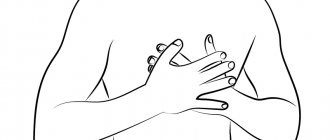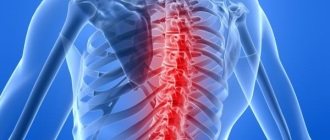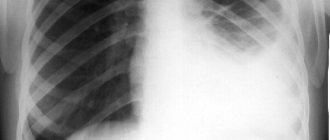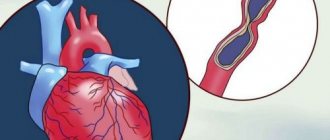Types of cardialgia
Psychogenic cardialgia progresses in a person against the background of depression or severe emotional shock. The patient exhibits the following symptoms:
- burning and pain in the area of the projection of the heart and in the left hypochondrium. The person notes that he either has a feeling of fullness in his chest, or, conversely, emptiness;
- the pain is constant, throbbing;
— the sensitivity of the skin in the area of the left nipple increases;
- with the psychogenic form of the disease, pain can radiate not only to the neck, spinal column or lower back, but also to the genitals.
Often the pain syndrome is accompanied by the following unpleasant sensations in certain parts of the body: tingling; crawling; numbness; tingling.
Vertebrogenic cardialgia develops when the cervical spine is affected. Pain syndrome manifests itself when the roots of the nerves that exit this part of the spine are compressed. These nerve fibers have a reflex effect on the heart and coronary blood vessels, as a result of which pressing or aching pain occurs in the area of the projection of the heart muscle.
Cardialgia and abdominalgia of vertebrogenic and myofascial origin
Pain is an extremely complex phenomenon, and the search for the causes of pain does not always end with a clear somatic diagnosis. In a number of patients, the nature of thoracic and abdominal pain remains unclear, which leads to diagnostic and treatment errors, incorrect choice of treatment tactics, and even unjustified surgical interventions. Thus, in 10–30% of cases after appendectomy, histological examination does not reveal any morphological changes, while the clinical picture of acute appendicitis may be caused by vertebrogenic pseudoappendiceal Lehman syndrome, which occurs when 10–12 lower thoracic roots are affected on the right. Coronary angiography performed in patients with a clinical picture of typical angina pectoris reveals the normal state of the coronary arteries in 10–20% of these patients, and in patients with an atypical picture of angina pectoris, unchanged coronary arteries are found in 70% of cases [1, 2]. Patients with cardialgia and abdominalgia of vertebrogenic and myofascial origin, as a rule, search for the substrate of their disease for a long period of time, and the possibility of pain in connection with musculoskeletal and autonomic factors most often seems unlikely to them. Often, internists, having not found the anatomical substrate of the pain syndrome, experience difficulties in the management of such patients and refer them to a neurologist. Therefore, the neurological view of this problem is becoming increasingly relevant.
Cardialgia of vertebrogenic and myofascial origin
The formation of cardialgia against the background of spinal pathology is due to the presence of close connections between the cervical spinal motion segments (SMS) and the heart through the sympathetic formations of the cervical region with the corresponding segments of the spinal cord. There may be two circles of pathological impulses: proprioceptive - from the affected SMS (spine, transverse costal joints, cervical rib, anterior scalene muscle, scapula, chest, arm) to the projection zone of the dermatome, myotome and sclerotome; afferent - from the heart through the phrenic nerve, the spinal cord into the periarticular tissues of the cervical spine and upper shoulder girdle, with subsequent projection onto the skin into the corresponding Zakharyin-Ged zones. Painful impulses from these vicious circles reach the cerebral cortex along the spinothalamic pathway. As a result, pain associated with damage to the spine and peripheral joints of the upper limb can be projected onto the heart region, often simulating attacks of coronarogenic chronic as well as acute coronary heart disease [3, 4]. An important and common mechanism of cardialgia of non-coronary origin is irritation of the endings of the sinuvertebral nerve with a subsequent compensatory reaction in the form of spasm of certain muscle groups of the upper quadrant zone with their biomechanical overload, that is, with the formation of myofascial dysfunction with the formation of trigger points and, accordingly, the occurrence of pain. Myofascial syndromes can develop against the background of degenerative-dystrophic changes in the spine, but they can also have a different genesis (trauma, sprain, muscle strain, etc.). The main clinical forms of myofascial disorders, in which pain in the chest and heart region can occur, are the syndromes of the pectoralis major and minor muscles, and less commonly, the anterior scalene muscle syndrome [5, 6].
Cardiac syndrome of vertebrogenic and myofascial origin is characterized by muscular-tonic and dystrophic changes in the anterior chest wall with characteristic pain manifestations. Patients may complain of pain in the left half of the anterior chest wall, of a constant nature, but intensifying with sharp turns of the head, torso, abduction of arms to the sides, lifting heavy objects, severe coughing, sometimes the pain appears or intensifies when lying on the left side. Typically, patients regard such pain as cardiac pain, but note that taking nitrates does not have a positive effect. Palpation of the muscles of the anterior chest wall reveals signs of myofascial dysfunction in the form of local painful areas and compactions. Pathognomonic signs of myofascial pain are myofascial trigger points - areas of local pain in the muscle, mechanical pressure on which causes not only intense local, but also referred pain. The occurrence of pain and activation of trigger points in the pectoralis major muscle occurs when lifting heavy objects, especially in front of you, when loading the arm in an abducted position, and when staying for a long time with lowered shoulder girdles, which leads to contraction of the muscle. The pain radiates along the anterior surface of the chest wall, the medial surface of the shoulder and forearm. With myofascial dysfunction of the pectoralis minor muscle, which occurs as a result of trauma during sudden or prolonged lateral abduction of the shoulder and throwing back the arm, including during sleep, when working with outstretched and raised arms, the pain resembles angina pectoris. Pain sensations are localized along the midclavicular line at the level of the III–V ribs and radiate into the arm along the ulnar edge to the hand, accompanied by paresthesia. This is due to compression of the neurovascular bundle between the coracoid process of the scapula, the first rib and the tense pectoralis minor muscle. Pain and activation of trigger points intensify when walking with a cane, coughing, or compression of the muscle by the strap of a bag or backpack.
Costosternal syndrome (“anterior chest wall syndrome,” “costochondritis,” “costosternal chondrodynia”) is one of the most common causes of chest pain. Palpation reveals multiple areas of pain: in the left parasternal region, in the projection of the pectoral muscles and sternum. When the upper costal cartilages are affected, the pain radiates to the heart area, usually intensifying with movements of the chest. The pain can be shooting and lasting a few seconds, or dull, aching, lasting several hours or days. There is often a feeling of tension associated with pain due to muscle spasm. Palpation of the area of the costochondral joints helps to identify the source of pain if it is located in these sections. For the purpose of differential diagnosis with coronary pain, intercostal nerve blocks are used with the introduction of local anesthetics along the posterior axillary line, which bring pronounced relief to patients. Pain when pressing on the xiphoid process of the sternum (xyphodynia or xyphoidalgia) may be accompanied by pain along the anterior surface of the chest and in the epigastrium. The intensity of pain can vary from mild to high and requires the exclusion of coronary pathology or acute diseases of the abdominal organs. Pain may occur or intensify when bending forward and turning the body, and especially after eating, leading to an increase in pressure behind the xiphoid process. With deep palpation of the xiphoid process, pain can radiate to the sternum, as well as to the shoulder girdle and back. No specific radiological changes were detected in xyphoidalgia.
Diagnosis of myofascial pain is based on the results of local palpation of the muscles of the anterior chest wall (major, pectoralis minor and others), assessment of muscle function, identification of trigger points and pain intensity, palpation of parasternal points. Characteristic of cardialgia of vertebrogenic and myofascial origin are the connection of pain with the movement of the spine (flexion, extension, rotation of the neck and torso), increased pain when coughing, sneezing, straining; muscle tension and soreness on palpation. When examining patients, signs of vertebral syndrome are revealed (deformation and biomechanical disorders of the spine, limitation of movements in it, tension and soreness of the paravertebral muscles, the presence of zones of hyperesthesia or hypoesthesia). Reducing pain during therapeutic and drug blockades, “dry puncture”, manual therapy, and post-isometric relaxation is of diagnostic importance. Changes in spondylograms confirm the presence of degenerative-dystrophic changes in the spine in the patient, but it must be remembered that the detection of these signs is not yet a sufficient argument for considering the connection between pain in the heart area and the presence of degenerative changes in the spine. Only a thorough examination and cooperation of doctors of different specialties will eliminate coronary causes of cardialgia. In addition, it is important to know that with increased vertebrogenic myotonic reactions against the background of a dystrophic process in the cervical motor segment in patients with coronary atherosclerosis, so-called reflex angina is possible, that is, cardiovascular pain syndrome of mixed origin [7]. Therefore, a combination and layering of symptoms of vertebrogenic pathology and coronary heart disease is possible, which often complicates diagnosis and, accordingly, adequate therapy.
Abdominalgia of vertebrogenic and muscular nature
The nature of these abdominal pains is determined by vertebro-vegetative-visceral relationships, which is explained by the anatomical and physiological features of the structure of the somatic and autonomic nervous systems, the interaction of which occurs with the close participation of the spine. There are non-reflex and reflex options. In non-reflexive, primary nociceptive afferentation from the affected organ can destabilize the mechanisms for processing sensory signals at the entrance to the segmental apparatus. This leads to irritation of neurogenic groups of the dorsal horn of the spinal cord with excitation of sensory channels belonging to the myoderm and the development of hyperalgesic areas in the dermatome, myotome, sclerotome and splanchnotome - the so-called “vicious circle” of viscerovertebrovisceral influence is formed. The reflex variant can be of a vertebrovisceral, visceromotor and viscerosclerotomy nature. The basis for understanding reflex vertebrobdominal pain should be the fact that the presence of organic damage to the nerve trunks is not necessary; in this case, impulses are transmitted from receptors of the affected spine or other tissues [8, 9]. With this type of pain, a vicious circle of vertebrobviscerovertebral influences can form. The vertebrogenic nature of pain can be caused by degenerative changes in the spine, tuberculosis, tumor or spinal injury. In vertebrogenic diseases, referred pain in the abdominal area is characterized by simultaneous and more pronounced pain directly in the area of the vertebrae and back, local tension in the back muscles, pain upon percussion of the corresponding vertebra or its joints, and limited mobility. Moreover, when the process is localized in the lower thoracic segments, reflex muscular-tonic and compression syndromes manifest themselves in the form of unilateral or bilateral girdle pain in the abdominal area (usually in the area of one or another root), sometimes local changes in muscle tone, which have a clear connection with movements in the spine .
There are three groups of vertebrogenic visceral syndromes:
a) visceralgic syndromes - characterized by the prevalence in clinical practice of pain that is localized in the area of a specific organ; the mechanism of their occurrence is associated with irritation of the radicular structures, sympathetic ganglia, as well as a violation of the autonomic neurotrophic regulation of internal organs (for example, ischemic disorders caused by regional changes in vascular tone); b) viscerodysfunctional syndromes - manifested by dysfunction of an organ without the occurrence of pronounced organic changes in its tissues (for example, vertebrogenic gastrostasis or flatulence); this syndrome is especially characteristic of lesions of the nodes of the borderline sympathetic trunk; c) viscerodystrophic syndromes of vertebrogenic nature - lesions of internal organs arise due to a violation of the neurotrophic function of the autonomic nervous system; in essence, they constitute the initial stage of the formation of a somatic disease, which can later develop into a certain nosological form [10, 11].
Myofascial pain syndromes, accompanied by abdominal pain, are characteristic of local muscle hypertonicity in the area of the rectus, oblique, transverse abdominal muscles, iliocostal muscles of the chest, multifidus muscles and pyramidal muscles. The genesis of such pain is not only vertebrogenic causes, but long-term muscle tension, for example, in athletes, injuries to the abdominal wall, operations in this region, etc. Patients may complain of “burning in the abdomen” or “heaviness”, pain is often unilateral localized, combined with pain in the lower back and back of a permanent nature. Important characteristics of such pain are the connection with body movement, changes in intra-abdominal pressure, and limitation of movements. For myofascial pain, painful muscles and trigger points are identified. Sometimes symphysosternal Brugger syndrome develops: usually after several lumbargic episodes, at the moment of physical overexertion, pain appears in the abdominal wall, which becomes constant and intensifies with coughing, sneezing, and sudden turns of the body [12]. Radicular syndromes at the thoracic level of the spine are rare, so radicular abdominalgia is uncommon. The diagnosis of vertebro- and myogenic abdominalgia is confirmed by the good effect of nonsteroidal anti-inflammatory drugs (NSAIDs). Doctors often use the term “intercostal neuralgia” for pain in the abdomen or chest, but under the guise of this term, myofascial, radicular pain or postherpetic neuralgia most often appear. Intercostal neuralgia is not currently identified as an independent nosological form [13].
Therapy for vertebrogenic and myofascial cardialgia and abdominalgia should be aimed at the vertebral and extravertebral mechanisms of pathogenesis in accordance with the existing tactics for the treatment of vertebrogenic and myofascial syndromes [14]. Combinations of NSAIDs and muscle relaxants are of great importance in treatment. The use of muscle relaxants allows you to reduce the dose of NSAIDs and thereby reduce the possibility of unwanted effects. When choosing NSAIDs, preference should be given to drugs with greater analgesic and anti-inflammatory activity. When choosing a drug, it is important to have several dosage forms; it is more advisable to start treatment with injection forms and switch to tablets. Among muscle relaxants, you should choose drugs with the fewest possible side effects and greater therapeutic breadth. An effective method of local influence is therapeutic and drug blockades, their main goal is to block pain and eliminate its etiopathogenetic basis. The most commonly used combination of several drugs: dexamethasone, lidocaine, cyanocobalamin. It is possible to use local therapy with drugs with chondroprotective effects, for example, chondroitin and glucosamine sulfate. This allows you to reduce the need for NSAIDs and improve the metabolism of cartilage tissue; in addition, these drugs have some analgesic effect. Non-drug methods of therapy are also used: physiotherapy, manual therapy, post-isometric relaxation, “dry punctures”, exercise therapy, acupuncture, transcutaneous electrical stimulation, electromagnetic therapy, etc. One of the promising directions for correcting the muscular-tonic component is the use of biofeedback methods. Modern and promising methods of non-drug therapy include kinesio taping. This method appeared in the mid-1970s. and is based on the use of special elastic cotton tapes coated with hypoallergenic acrylic glue for fastening to the patient’s skin. With the help of kinesio taping, you can normalize muscle tone using muscle techniques by influencing superficial and deep tissue proprioception. These techniques can be used to correct pathobiomechanics, indirectly affecting muscle tone [15]. Lymphatic drainage kinesiotaping techniques can locally improve microcirculation and tissue perfusion. Analgesic and anti-inflammatory effects appear a few minutes after application of the tape; the patient feels a decrease in pain, warmth in the area where the tape is applied, and an increase in range of motion. The use of various techniques for applying kinesio tape provides a unique opportunity to correct the biomechanics of each patient, taking into account his individual characteristics, which contributes to a more effective regression of pain manifestations.
Patients with cardialgia and abdominalgia of vertebrogenic and myofascial origin, having a pathology “at the intersection of specialties,” present a considerable diagnostic and therapeutic difficulty for the practicing physician. That is why cooperation and collegiality between doctors of various specialties is important in deciding on the final diagnosis and choosing the optimal treatment tactics.
Literature
- Moldovanu I.V. Abdominalgic syndrome. In the book: Autonomic disorders / Ed. AM Wayne. M., 1998.
- Danilov A. B. Cardialgia and abdominalgia. Pain syndromes in neurological practice / Ed. Veina A. M. M.: Medpress-inform, 2001. 284–292.
- Zaslavsky E. S. Painful muscular-tonic and muscular-dystrophic syndromes (etiology, pathogenesis, clinical picture, treatment). Diss. ... MD Novokuznetsk, 1980. 252 p.
- Travell D. G., Simons D. G. Myofascial pain. T. 1. M.: Medicine, 1989. 255 p.
- Ivanichev G. A. Myofascial pain. Kazan, 2007. 392 p.
- Esin R. G., Erpert D. A. Myogenic pain syndrome. In the book: Pain. Principles of therapy, pain in manual medicine / Ed. R. G. Esina. Kazan: Offset Company, 2008. pp. 120–131.
- Yaroshevsky A. A., Morozova O. G. Musculoskeletal pain in the chest area as an interdisciplinary problem // News of medicine and pharmacy, 2012. No. 405. pp. 34–40.
- Popelyansky Ya. Yu. Orthopedic neurology. Vertebroneurology. A guide for doctors. Kazan, 1997. T. 1. 554 p.
- Danilov A. B. Abdominalgic syndrome. In: Pain syndromes in neurological practice / Ed. A. M. Veina. MEDpress-inform, 2001. 368 p.
- Merzenyuk O. S. Reflex vertebrobvisceral syndromes: new approaches in manual therapy: dis. ...Dr. med. Sci. Krasnodar, 2001. 306 p.
- Vasilyeva L. F. Manual diagnosis and therapy of dysfunction of internal organs. Novokuznetsk, 2002. 243 p.
- Rybak V. A., Gordeeva I. E., Barulin A. E. Abdominalgia syndrome in neurology // Medicine Bulletin. 2013. No. 1. pp. 13–20.
- Golubev V. L. Pain syndromes in neurological practice. 3rd ed. 2010. 336 p.
- Podchufarova E. V., Yakhno N. N. Pain in the back and limbs. In the book: Diseases of the nervous system: A guide for doctors / Ed. N. N. Yakhno. M., 2005. T. 2. pp. 306–331.
- Barulin A. E., Kalinchenko B. M., Puchkov A. E., Ansarov Kh. Sh., Babushkin Ya. E. Kinesiotaping in the treatment of pain syndromes // Volgograd Journal of Medical Scientific Research. 2015. No. 4. pp. 29–31.
T. L. Vizilo1, Doctor of Medical Sciences, Professor A. D. Vizilo A. G. Chechenin, Doctor of Medical Sciences, Professor E. A. Polukarova, Candidate of Medical Sciences
Federal State Budgetary Educational Institution of Further Professional Education RMAPO Ministry of Health of the Russian Federation, Moscow
1 Contact information
Symptoms of cardialgia
As the disease progresses, the following symptoms appear:
- pain syndrome localized in the left half of the chest, behind the sternum. In rare cases, pain also occurs in the armpit area. It is noteworthy that pain directly depends on the position of the person’s body. For example, it can intensify if a person bends forward or raises his left arm up;
- sleep disturbance; sense of anxiety;
- violation of the swallowing reflex;
- darkening of the eyes;
- the patient cannot take a full breath, so he has a feeling of lack of air;
- in severe cases, the development of pre-fainting or convulsions is possible;
- if the symptoms of the disease appear in a state of complete rest, then this may indicate the progression of neurocircular dystonia. In this case, the following symptoms join the main clinical picture: constant fatigue, weakness, lethargy, decreased performance.
Pain Clinic
Cardialgia
- This is pain in the heart area.
It is a symptom of most diseases. Vertebrogenic cardialgia is quite common. Most authors associate them with osteochondrosis of the cervical and thoracic spine. Cardiac syndrome is manifested by painful sensations in the heart area. These are pinching, aching pains, a burning sensation, compression of the heart. They haunt the patient for many days, months; less often, attacks of acute stabbing pain occur in the area of the apex of the heart, “under the heart,” which are accompanied by increased pulsation and heart failure. At times, the pain can spread to the entire chest, neck, and abdomen. Taking nitroglycerin does not relieve pain; it is not associated with physical stress and is more pronounced in the morning. The syndrome of vertebrogenic cardialgia in connection with the pathology of the cervical spine is caused by reflex effects on the heart, coronary arteries through the cervical sympathetic nodes and the cardiac nerves extending from them. Patients have a history of cervical lumbago, cervicalgia, radiculitis caused by osteochondrosis, spondyloarthrosis. With the next exacerbation of pain in the neck, painful sensations appear in the area of the heart of a compressive nature, reminiscent of angina pectoris, but without irradiation to the arm, clearly associated with head movements. They are provoked by prolonged stay in an uncomfortable position with a fixed position of the head (reading while lying in bed, working at a computer, sleeping on a high pillow, installation work with the head thrown back, etc.). Complex treatment with the use of intraosseous blockades leads to regression of the clinical manifestations of vertebrogenic cardialgia. We have proven that intraosseous blockades are a pathogenetic method of treating spondylogenic vertebral-cardiac disorders.
The impact of intraosseous blockades at the cervicothoracic level of the spine leads to the most pronounced regression of vertebral-cardiac disorders, which indicates the universal pathogenetic significance of the osteogenic factor in the development of this pathology. Clinical examples of successful treatment of pain in the heart area and other manifestations of thoracic osteochondrosis using intraosseous blockades:
- Patient with pressing, aching pain in the left half of the chest and pain in the thoracic spine
Patient with aching pain in the thoracic spine, pain under the left shoulder blade and left half of the chest
Scientific articles devoted to the effectiveness of intraosseous blockades in the treatment of vertebrogenic cardialgia:
- Intraosseous blockades in the treatment of pain, cardiac dysfunction and cognitive impairment in patients with cervicothoracic dorsopathy. — Kornilova L.E., Sokov E.L., Artyukov O.P., Garabova N.I. Department of Nervous Diseases and Neurosurgery, RUDN University, City Clinical Hospital No. 64
- Dynamics of pain syndrome, cardiac dysfunction and cerebral disorders in patients with vertebrogenic cardialgia during treatment with intraosseous blockades - Filimonov V.A., Sokov E.L., Kornilova L.E. Federal State Institution "Clinical Hospital No. 119 FMBA of Russia", Moscow Peoples' Friendship University of Russia, Moscow
- Osteogenic factor in the pathogenesis of vertebrogenic cardialgia, intraosseous blockades in their treatment. — Sokov E.L., Kornilova L.E., V.A. Filimonov, P.A. Ganjula. Department of Nervous Diseases and Neurosurgery, RUDN University. City Clinical Hospital No. 64. Federal State Healthcare Institution Clinical Hospital No. 119 FMBA. Bulletin of the Peoples' Friendship University of Russia. Series “Medicine”, No. 6, 2008.- p. 90-96.
- Osteogenic factor in the formation of combined spondylogenic vertebral-basilar and vertebral-cardiac disorders - E.L. Sokov, L.E. Kornilova, V.A. Filimonov, V.N. Klyueva. Department of Nervous Diseases and Neurosurgery of the RUDN University, City Clinical Hospital No. 64, Clinical Hospital No. 119 of the Federal Medical and Biological Agency
- Comparative effectiveness of intraosseous and paravertebral blockades in patients with vertebrogenic cardialgia in combination with coronary heart disease. — V.A. Filimonov, Sokov E.L., Kornilova L.E., P.A. Ganjula. Department of Nervous Diseases and Neurosurgery, RUDN University. City Clinical Hospital No. 64. Federal State Healthcare Institution Clinical Hospital No. 119 FMBA. Journal of Living Systems Technologies, 2009, volume 6, no. 1, pp.-59-64.
- The effectiveness of paravertebral blocks in the complex treatment of patients with a combination of neurological manifestations of cervicothoracic osteochondrosis and coronary heart disease - L.E. Kornilova, V.A. Filimonov, E.L. Sokov, P.A. Ganjula. Department of Nervous Diseases and Neurosurgery. Russian State University of Peoples' Friendship; Clinical Hospital No. 119 FMBA; City Clinical Hospital No. 64, Moscow
Diagnosis of cardialgia
If pain occurs in the area of the projection of the heart, it is important to immediately visit a medical facility for a full diagnosis of this condition, because such a symptom may indicate both cardialgia and the presence of pathologies of the cardiovascular system. Only a qualified specialist will be able to conduct a competent differential diagnosis and prescribe adequate treatment.
The standard diagnostic plan for cardialgia includes the following examinations: echocardiography; X-ray; EGDS of the stomach; ECG; Ultrasound; MRI of the heart; CT scan of the heart.
Complications and consequences
Complications and consequences of cardialgia depend on the cause that caused it.
- Some diseases are characterized by a favorable course, for example, neuro-circulatory dystonia (disorder of the nervous system) or osteochondrosis (destruction of intervertebral discs with compression of nearby nerves).
- Other diseases, if not detected in a timely manner, significantly worsen the quality of life and can shorten its duration. For example: tumors of the mediastinum and lungs can cause breathing difficulties and bleeding into the chest cavity;
- myocarditis (inflammation of the heart muscle) leads to heart rhythm disturbances and heart failure;
- Gastric ulcer (formation of defects in the stomach wall) can be complicated by ulcerative bleeding or malignancy (transition to a cancerous tumor).











